After much planning and organisation, the Murihiku Enviroschools team successfully gathered over 220 students, teachers, and organisations together to run our much-anticipated Enviroschools Regional Hui 2022. This year we decided to run three events back-to-back in three of our catchments, Oreti, Aparima and Mataura. After reading this article you might also enjoy watching the video below!
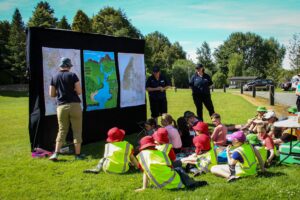
Getting to understand the dynamics of a catchment.
Our hui focus this year was around the Enviroschools ‘water of life’ theme area, with an overarching goal of encouraging children to engage with their local awa and to take collective action towards a sustainable future. The Enviroschools Hui promotes authentic facilitation and learning opportunities that encourage collaboration between schools and community groups. Many of the activities were designed to be student-led, helping to empower students to become drivers of change.
“We hosted students from Mataura, Oreti, Aparima and Waiau river catchments and the feedback we received was overwhelmingly positive. This hui is an excellent opportunity to support the enviro-leaders of tomorrow and to foster a deeper connection between schools, agencies, and communities with their nearby waterways.” – Josh Sullivan, Enviroschools Regional Coordinator, Senior Education Advisor, Environment Southland Te Taiao Tonga
Each day was broken up into a series of linked experiences which helped to develop a greater appreciation for the local catchment and for protecting the health of their local waterways. We wanted to create opportunities for students to become curious about their local awa and invite them to ask questions that might create a deeper level of connection.
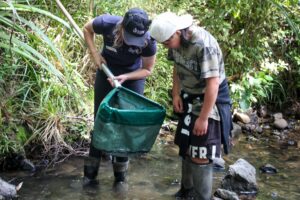
Careful observation: Becky Crack-Land, Sustainability Officer, Environment Southland captures interest.
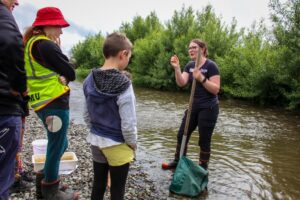
Learning about what influences water quality and how to measure this. Microplastics are not easy to see with the naked eye.
There were three key stations set up each day which included microplastics, understanding catchments and macroinvertebrate studies. The kaiako at each station helped build students’ understanding of these topics and offered fresh insights about the importance of protecting our awa for generations to come.
Some of the highlights of the day included identifying microplastics under a microscope. This eye-opening task prompted rich dialogue. Students talked about where the plastics originated and discussed manufacturing techniques and what happens when we wash our clothing.
“I liked looking through the microscope at the microplastics and learning about primary and secondary plastics” one student stated.
The fish dissection was of particular interest to some students. They were amazed at how many stonefly larvae and worms were inside the stomach of these fish. The children took time to identify the different organs and features of the trout that allowed them to thrive in an aquatic environment.
From a student perspective, “I never knew rainbow trout liked to eat beetles and bugs. There were sooo much in their stomachs!”.
As the day of experiential activities progressed it became obvious that students were beginning to see the interconnections between these topics.
“I enjoyed learning about the fish and finding out where their intestines were. Something I want to do more of and inquire about is the macroinvertebrates and how they help the health of the water. I learnt that native fish breathe through their skin”. – student comment
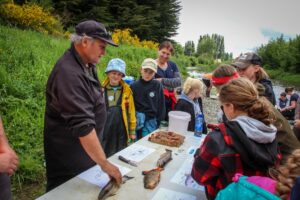
These introduced fish species were used to help explain the food chain and adaptation to aquatic life.
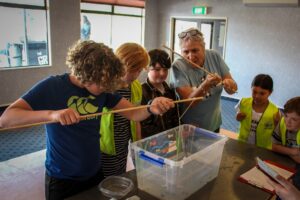
Fun and games!
Teachers who accompanied students at these stations mentioned, “It’s truly fantastic to see the range of hands-on activities that students get to engage with. They seldom get opportunities like this, so I know they will be talking about this for weeks to come!”
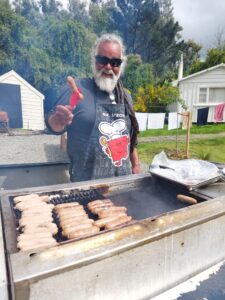
Supporting the food chain.
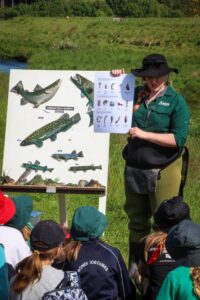
Explaining fauna in our freshwater catchments and how they can indicate the health of waterways.

Thinking about where these microplastics enter our waterways and why they are an issue.
As this event was a collaboration between several organisations such as Thriving Southland, Te Pūkenga (formerly known as S.I.T) and Environment Southland, it highlighted our strengths as a tight knit community wanting to have a positive influence on the environment and society as a whole.
One of the unexpected highlights of the hui was the number of invites we have since received to co-host events with our community partners in 2023. Our goal for future events is to weave mātauranga Māori understanding, science, and language together in an effort to create a rich tapestry of learning for our ākonga.

Looking more closely at a Southland kōura, found in freshwater streams.

These introduced fish species were used to help explain the food chain and adaptation to aquatic life.
“As the Regional Co-ordinator of the Enviroschools Programme, it has been fantastic to receive so much positive feedback about the event from teachers, students, and our community partners. Inviting managers, councillors and other organisations along has helped to showcase the strengths of the Enviroschools kaupapa.” – Josh Sullivan

Showing the underside of kōura.
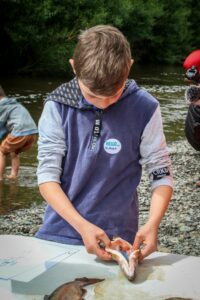
Examining the internal structure of the fish.
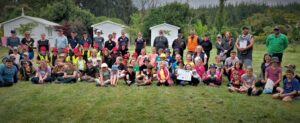
Oreti Catchment group.
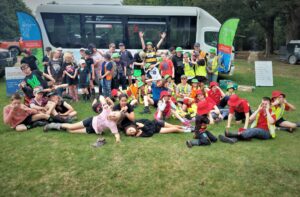
Celebrating a successful day at Mataura.